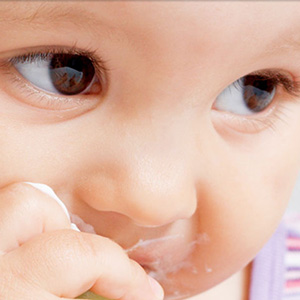Breastfeeding mums often ask me about introducing formula milk. They want to know what’s the best baby formula for breastfed babies, how much to offer and how to get their baby to drink it! This blog looks at what you need to know about introducing formula to your baby.
I’m here to support your choices
As a lactation consultant (and dietitian), it’s my job to support your breastfeeding journey. And this might mean at some point helping you if you want to introduce formula milk. You may want to replace one or two breastfeeds during the day or wean entirely onto formula.
Reasons you might have for wanting to introduce formula to your breastfed baby:

1. To help the baby to sleep better.
Introducing formula doesn’t mean that your baby will sleep for longer at night. As you probably know, babies wake at night for lots of reasons.
Check out this great little video from Prof Amy Brown on babies sleep.
2. Fears that baby isn’t getting enough breastmilk.
It’s not uncommon to notice changes in you and your baby’s feeding as they get older.
At about six weeks, your milk supply starts to regulate. Your breasts feel less full and softer, and you may stop leaking, feel the let-down less. Or notice that you’re pumping less milk.
Kellymom says, “This doesn’t mean that milk supply has dropped, but that your body has figured out how much milk is being removed from the breast and is no longer making too much. This change may come about gradually or seem rather sudden. Many people are not aware that these breast changes are normal because so many mothers stop breastfeeding early on and never see this change (or mistakenly interpret this change as a sign that milk supply has dried up and wean because of this change).”
3. Mum is returning to work.
Whether you give decide to give a formula depends on whether you can or want to express at work. Or on whether you work full-time or part-time. Usually, there is a range of options available depending on your circumstances.
4. Mum wants a break away from the baby.
Not every mum wants to express milk. But it’s also not always necessary. When your baby is eating three meals a day, you’ll have more flexibility about leaving your baby while you get a break for a few hours. While you’re out, they can eat and drink water. When you return, you can feed them your milk.
LEARN MORE: Want to take the confusion out of introducing solids to your breastfed baby?
Whatever your reason, make sure it’s entirely your decision to introduce formula and that you’re doing it because it’s what YOU want. And not because you feel trapped or someone else thinks you should!
Will giving some formula affect my supply?
That depends on whether or not your supply is well established. For many mums, this happens somewhere around the 6-week mark. Your supply is quite flexible from then on. So if you introduce a bottle and your supply drops you can build it back up again by cutting out the formula or expressing at that time. But if you’re happy with giving that bottle of formula every day, it doesn’t matter. Your body will adjust and make the milk that your baby needs.
What are the main differences between breastmilk and baby formula?
Breastmilk is a unique living substance that’s impossible to recreate. It’s a complex liquid containing all the nutrients your baby need in easily absorbed forms. Breastmilk also has a range of protective extras tailored to your baby and the environment you and your baby live.
Just a few of the amazing substances in your breastmilk include:
- Long-chain polyunsaturated acids (LCPUFAs)-As well as reducing chronic diseases like diabetes and heart disease. They also enhance eye and brain development.
- Melatonin helps with sleep.
- Lots of things beginning with L (thanks to Prof Amy Brown for pointing that out!) Lactoferrin helps with iron absorption. Lactoalbumin suppresses tumour development. Lactoglobulin has antioxidant effects and lysozyme, which destroys bacteria. Leptin helps your baby know when he/she is full.
- Cholecystokinin (CCK); helps babies to relax. CCK rises and then falls after 15 minutes. If you’ve ever wondered about why your baby appears to be fast asleep and then wakes up after 15 minutes, this is why!
- Bacteria: Not only does breastmilk contain bacteria (that’s a good thing for your baby’s immune system), but it also contains HMOs, which are sugars to feed good bacteria in your babies gut. Although some companies add these to formula milk, these are 1-2 synthetic HMOs compared to over 200 different types of breastmilk. We don’t have enough evidence to know if added HMOs will have the same effect.
Learn more about the wonderful science of breastmilk
What is the closest formula to breastmilk?
None of them!
As we’ve seen, it’s impossible to recreate breastmilk. Breastmilk isn’t only nutritionally uniquely suited to our human babies; it also contains hundreds of unique components and living cells to protect your baby from infection and promote optimal development.
Just because scientists can isolate an ingredient from breastmilk and recreate it in a lab doesn’t mean it has the same benefits. Manufacturers often make claims for ingredients like HMOs, but frequently these synthetic ingredients show no benefit.
All baby formula must meet EU regulatory standards. This means ANY baby formula on the market will meet your baby’s nutritional needs. Experts constantly review these standards. And if they see evidence that an ingredient is beneficial for a baby’s health and development, they change the criteria. Then, it goes into ALL baby formula.
There’s NO formula on the market that is THE best baby formula on the market. Or one formula that is closer to breastmilk than any other.
Is cheap own-brand baby formula as good as expensive branded formula?
As I’ve explained above, baby formula is regulated.
Therefore both the cheapest and the expensive formula are nutritionally similar. And manufacturers must add any ingredients with proven benefits regardless of how much they’re charging for the end product. The main difference between the cheapest and most expensive formula is how much money companies spend on packaging and marketing! They intentionally market specific kinds of milk to parents with more money willing to pay a premium! But just because it’s more expensive doesn’t mean that you’re getting a better product.

Read more about baby formula companies marketing practices.
Will hungry baby formula help my breastfed baby to sleep better?
No.
There’s no evidence that hungry baby formula babies works or is even suitable for babies. Both the HSE and NHS recommend first infant formula or stage 1 until your baby’s first birthday. Hungry baby formula has a whey: casein ratio similar to cows’ milk with more casein than whey. Manufacturers claim that this higher casein content slows stomach emptying, meaning your baby stays fuller for longer, and you get a better night’s sleep. But there’s no evidence supporting this.
If I want to introduce some formula after six months, should I use a follow-on formula?
No.
Babies don’t need to ‘move on’ to follow-on formula at six months of age. And The World Health Organisation (WHO) has clearly stated that a follow-on formula isn’t needed. If you’re introducing formula alongside breastmilk or are fully formula feeding, then stick with first infant formula until your baby’s first birthday. Then you can switch to cow’s milk alongside breastfeeding or as the main milk drink.
How to switch from formula to cows milk?
So, why is follow-on formula on the market then?

Simply because baby milk companies aren’t allowed to advertise first infant formula, and formula manufacturers want parents to buy THEIR product. So they need a way for parents to get familiar with their brand packaging, colours and messages without breaking the law. Look out for this on TV. You’ll see ads for follow on formula but never for first infant formula.
You can read more here about the WHO Code on the marketing of breastmilk substitute.
If I’m offering a bottle of formula to my breastfed baby, how much do I put in?
You’ll see guidelines on the formula tin. Ignore these! These guidelines show typical volumes of formula to use according to the age and weight of the baby. These can be confusing as they vary from brand to brand and don’t always describe the same ages and stages. All feeding guidelines are just guides, and you mustn’t get too hung up about your baby drinking exact amounts of milk. Your baby’s appetite will vary over the day, from day-to-day and, other babies. Most breastfed babies drink about 3-4 oz of milk at a time.
How can I get my breastfed baby to take a bottle of formula (or expressed breastmilk)?
- Have someone offer the bottle. Give them some of your clothing to wrap them in.
- Offer the bottle before your baby is too hungry.
- Offer short trials with the bottle first. If your baby resists, don’t keep at it until they’re upset. Let your baby play with it and put it away if they’re unhappy.
- Try different feeding positions. Many babies like to snuggle when given a bottle and look into the feeder’s eyes, but some babies won’t take a bottle when held in their usual feeding position. Instead, hold your baby facing forward, with their back against your chest or propped on raised legs, or try the bottle in the bouncer or buggy.
- Warm the bottle teat to body temperature by running previously boiled warm water over it before offering it. Or try dipping it in your warm milk.
- Tap your baby’s lip with the bottle teat, wait until your baby opens their mouth, and allow them to draw in the teat rather than pushing it in.
- Try walking, rocking or swaying while giving the bottle
- Experiment with different bottles and teats. I had the most success with the latex rather than the silicone teats.
- Try offering the bottle when your baby is drowsy or in a light sleep
- If your baby is older, give them a bottle to play with for a few days before attempting a feed
- Give some milk by spoon first, and then offer the bottle or let baby suck on a finger and slip in the bottle along the side as they suck.
(adapted from Breastfeeding Answers. A guide for Helping families by Nancy Mohrbacher).
How do you transition from all breastfeeding to all formula feeding?
Drop one breastfeeding (or pumping session) per week and replace it with formula. If you’re breastfeeding eight times each day, then it would take eight weeks to wean completely. This is a slow, gentle way for your baby to transition from breastfeeding and for you to reduce your supply. Some mothers like to keep one feeding for a longer time, such as a bedtime feeding. You can speed up this schedule if necessary by dropping one feeding every 2-3 days. If your breasts become engorged, then express a little for comfort. Remember to hug your baby to help with the transition.
You may experience a sense of sadness and loss during weaning. This partly because of a change in hormone levels. Observe your breasts for lumps and “hot spots”. Massage them during feedings until they go away. You may hand express milk or use a breast pump if you’re uncomfortably full just to relieve the fullness. If you develop a fever, red tender area, or lump that will not go away, contact your GP.









Hi Caroline,
I’m just wondering about kandamil formula. Does the oils really make a difference and wether it’s primarily whole milk it’s made from?
I’m exclusively pumping (nightmare) and might be transitioning to formula soon so just wanted your opinion.
Thank you
Hi Gill
The same rules apply to all formula. And so as long as you choose a First Infant Formula there’s really only minimal differences between them. This is no better or worse than any other first infant formula.
This is from First Steps Nutrition “As the fatty acids present in human milk differ in composition
and structure to those of either vegetable oils, cows’ or goats’ milk fat, multiple fat sources
are often used in infant milks in an attempt to recreate a fatty acid profile similar to
breastmilk”.
And the following “Kendal Nutricare made the following claims for their Kendamil milks on the company
website:
‘Milder and more natural taste than formulas made from skimmed milk.’
‘Retains all the natural goodness and benefits of full cream nutrients.’
‘Formulated to include the essential nutrients your baby needs to complement a
balanced weaning diet.’
These claims are not substantiated by reference to scientific evidence. It is important to
ensure families do not believe that whole animal ‘full-cream’ milk is a breastmilk alternative.
Claims suggesting that full cream milk is full of natural goodness and more wholesome for
infants could be misleading.
The company website stated that the product was made using whole milk. Whilst whole milk is
used in the product manufacture, after drying, it only accounts for about 16% of the dry weight
of the powder, the majority being composed of whey powder, vegetable oils and lactose”.
Extremely useful blog. Agree with all of your points and thanks for pointing in direction of Prof Brown. I’m having to move to formula at 9 months as my child has been on nursing strike for 3 weeks. Very sad but can’t get her back on. Pumping but exclusively pumping is so draining and limiting so introducing some formula. Didn’t expect to have to do it and didn’t want to but now I’m here I’m grateful for your blog.
Hi Kat. I’m so glad that you found the blog useful. It sounds like you’re doing a great job.
What about goats milk based formula ? My baby is settled on breast milk( only 10 days old) but he is a very hungry baby as he was born at 10 pounds 3.5 oz Would like to be able to give him to my partner/mum to feed him and not sure whether I want to start pumping as it seems to be very time consuming.
Thanks in advance
Hi Abby
Congratulations! You’re still very early days with establishing breastfeeding so it’s definitely worth getting a lactation consultant visit to talk about the options. If you do go down the formula route then it’s OK to use either first infant formula made from cow’s milk or goats milk. There is no advantage to one over the other.